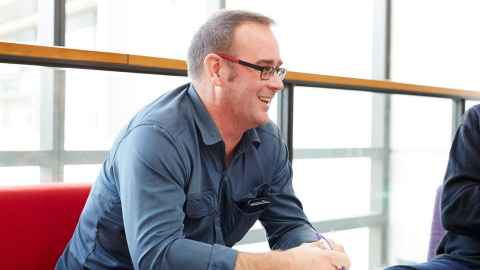Take 10 with... Justin O'Sullivan
Professor Justin O'Sullivan explains more about his genome research and how non-coding DNA could influence diseases like Parkinson's.

1. Describe your research topic to us in 10 words or less.
How does non-coding DNA contribute to our wellbeing?
2. Now describe it in everyday terms!
DNA is much more than the genes that it contains. Only about 2% of the DNA that is in each one of your cells actually codes for genes, so what we try to do is to understand how all of the other stuff – the other 98% - how does it actually affect your characteristics? One way we’re doing this is by looking at its impact in disease like Parkinson’s, diabetes, autism, mood disorders and neurological disorders. We are also trying to understand how you interact with your microbes and how they are affected by this non-coding DNA. What we want to do is move to a situation where we can use that information to diagnose, or help diagnose, people who have non-diagnosed disorders by normal methods.
3. What are some of the day-to-day research activities you carry out?
We look at big data, which means using computers to analysis data sets, a lot of writing and a lot of thinking. The real issue is not getting data - there are petabytes of data out there - but converting the data into knowledge, and that is done by hypothesis testing and by linking it to other information. We do a lot of thinking about what we get from our experiments and computational analysis, but the hardest part it is connecting it to the biology.
4. What do you enjoy most about your research?
Research is never the same, the questions are changing all the time, and the people are changing all the time. Our team changes constantly which means that we get new ideas and it is really exciting to be continually challenged. We are trying to go from being reductionists to doing things holistically, which is very difficult, but it’s the challenge that I most enjoy.
5. Tell us something that has surprised or amused you in the course of your research.
I’m surprised by my own ability to do some of it, and I am continually surprised in a positive way by the way that the people I work with approach problems. I am amused by the graph on the cover of the Movement Disorders journal that my lab group call ‘Justine’.
6. How have you approached any challenges you’ve faced in your research?
All research is a challenge; you just have to approach it step by step. I don’t like being told that I can’t do something, so the way I approach it is to just do it anyway. If it falls over on the way, then you figure out what went wrong: you go back and then you go forward again. I think it’s almost a case of being belligerent. Everything is achievable - we may not be able to achieve it right now, but there is a way to do it if we break it down and work on the bits we can do it.
7. What questions have emerged as a result?
We’re starting to ask if we can use whole genome sequences to stratify patients according to their risk for disease. Some people do this by using genetic variants associated with a disease in a population-based study to calculate a risk score. Instead of using one risk score we’re trying to combine everything we know to calculate a total burden score for an individual using every variant they have. This could tell us which patients are going to respond to a particular treatment, for example, for Parkinson’s, or what form of Autism they might have. We’re even asking whether we can decode a person’s DNA to work out what diseases they have when they don’t have a mutation inside a gene.
8. What impact is your research having or what impact do you hope it will have?
Our end goal is to tell clinicians what we think a person is suffering from and how they could be treated, because these mutations that are outside of a gene are changing the way genes work, and that is what predisposes someone to a condition.
9. If you collaborate across the University, or outside the University, who do you work with and how does it benefit your research?
Collaboration is a very personal thing. It’s about give and take and the skills you need at a particular time to solve a particular problem. I have many collaborators in NZ and around the world and they’re always changing. It makes our research a lot better because it gives us the opportunity to test our ideas in ways we may not have thought of. We also have to connect our assumptions to the biology, so we work with people with a good understanding of a disease who can help us connect back from our microscale view to what they are actually seeing.
We’re working with researchers at the Murdoch Children’s Research Institute on a longitudinal study of Australian children to understand vitamin levels in the population and to connect that to genetics. We also collaborate with the Garvan Institute of Medical Research and others for our Parkinson’s research. And of course we have lots of collaborations within the Liggins Institute for research into the microbiome, diabetes and growth hormone to name a few.
10. What one piece of advice would you give your younger, less experienced research self?
I should have learnt more computing when I was younger! Although if I’d done that then things might have turned out differently. I don’t think I’d actually change anything because we are the sum total of all our experiences. I suppose I would just tell myself to have fun because you only get to do this once.